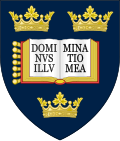 | |
| Parent institution | University of Oxford Wellcome Trust |
|---|---|
| Established | 1994 |
| Director | Holm Uhlig [1] |
| Staff | 470 |
| Key people | Yvonne Jones (deputy director) |
| Formerly called | Wellcome Trust Center for Human Genetics |
| Location | Henry Wellcome Building of Genomic Medicine, Oxford |
| Coordinates | 51°45′08″N1°12′55″W / 51.752248°N 1.215255°W |
 Interactive map of Centre for Human Genetics | |
| Website | www |
The Centre for Human Genetics (CHG) is a human genetics research centre of the Nuffield Department of Medicine in the Medical Sciences Division, University of Oxford, funded by the Wellcome Trust among others. [2]
Contents
- Facilities & resources
- Oxford Genomics Centre
- Research Computing Core
- Transgenics
- Cellular Imaging
- Research
- Statistical and population genetics
- References


